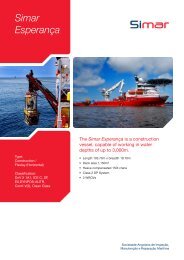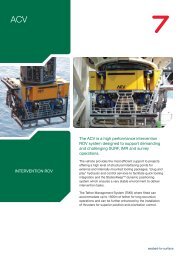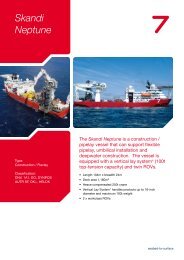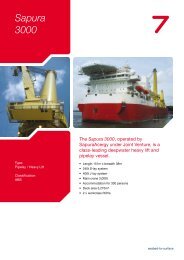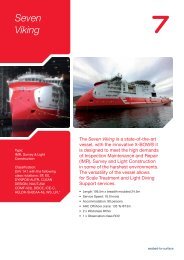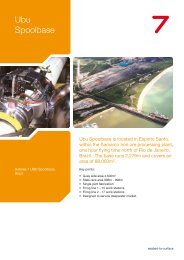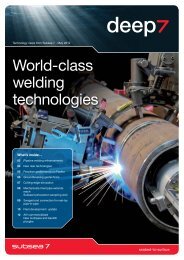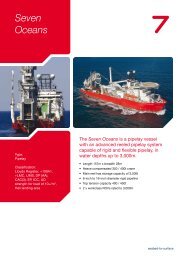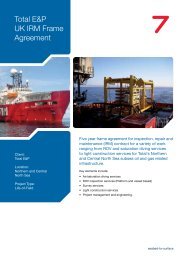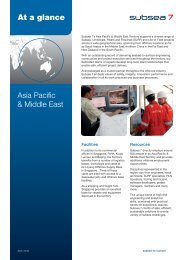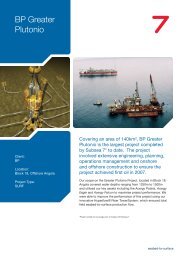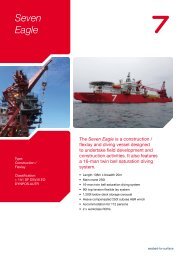Deep 7 - May 2013 - Subsea 7
Deep 7 - May 2013 - Subsea 7
Deep 7 - May 2013 - Subsea 7
You also want an ePaper? Increase the reach of your titles
YUMPU automatically turns print PDFs into web optimized ePapers that Google loves.
04<br />
Recent riser developments<br />
Dr Stuart N Smith, Vice President Technology & Asset Development<br />
Over many years, <strong>Subsea</strong> 7 has developed a unique suite<br />
of riser concepts and related technologies to meet a wide<br />
range of specific field characteristics, such as water depth,<br />
environmental conditions, host specification, hydrocarbon<br />
composition and client preferences.<br />
The continuous development of our riser technology is of<br />
great strategic importance in enabling our clients to meet the<br />
demands associated with ever-increasing challenges of water<br />
depth, corrosion, fatigue and harsh environments.<br />
Looking to the future, the growing demand for increased<br />
corrosion resistance, high-pressure capacity requirements and<br />
fatigue life is driving the need for new materials. High-strength<br />
steels and composite materials such as carbon fibre are now<br />
being considered as realistic future technological alternatives<br />
to conventional carbon steel. We are actively engaged in<br />
developing and qualifying a number of these novel initiatives<br />
(see page 6).<br />
The following overview provides an update of <strong>Subsea</strong> 7 riser<br />
developments associated with challenging offshore projects<br />
around the world.<br />
Hybrid Riser Tower (HRT)<br />
The Hybrid Riser Tower concept is a complex<br />
and effective riser system pioneered by <strong>Subsea</strong> 7<br />
over 15 years ago to gather all carried fluids for a<br />
deepwater or ultra-deepwater field into a vertical<br />
bundle for transfer to an FPSO.<br />
<strong>Subsea</strong> 7 is currently constructing two HRTs in<br />
Angola for Total’s CLOV project in 1,300m water<br />
depth in Block 17. As part of our continuous<br />
development programme, we are focussed on four<br />
main areas:<br />
• Investigation of the hydrodynamic behaviour<br />
which is sensitive to Galloping, VIV and VIM,<br />
through Basin test campaigns and CFD<br />
computations.<br />
Hybrid Riser Tower<br />
Steel Catenary Risers (SCRs)<br />
• Investigation of the use of non-metallic materials to save<br />
weight and reduce the amount of buoyancy required.<br />
Steel Catenary Risers (SCRs) are a preferred riser system for<br />
many field developments due to their cost efficiency, ease of<br />
installation and track record. Installation can typically be by<br />
all three methods available from <strong>Subsea</strong> 7: J-lay, S-lay and<br />
reel-lay.<br />
<strong>Subsea</strong> 7 installed the first-ever metallurgically clad SCR<br />
in Shell’s Bonga development offshore Nigeria by the J-lay<br />
method, followed by Exxon Mobil’s Erha development,<br />
also offshore Nigeria. Installation by reel-lay has also been<br />
performed in Brazil and the Gulf of Mexico.<br />
• Review of our design methodology to increase its<br />
sensitivity and efficiency by the extensive use of global<br />
modelling approaches and fatigue calculations.<br />
• Enhancement of our safety and maintenance<br />
performance by developing a top tower diverless<br />
connection system for flexible jumpers.<br />
The programme deliverables have already produced<br />
benefits on projects such as Total’s CLOV project in Angola,<br />
where the use of polymer materials has been adopted for<br />
the HTR Guiding Frames.<br />
The Steel Lazy Wave Riser (SLWR), an innovative derivative<br />
of the SCR, was also successfully installed on Shell’s BC-10<br />
project off Brazil in 1,800m water depth.<br />
A common requirement of most SCRs is the need for the<br />
highest quality welding and inspection technology, particularly<br />
in the case of installation by reel-lay.<br />
Qualification of the required welding technology for reel-lay<br />
was successfully performed by <strong>Subsea</strong> 7 to confirm:<br />
DEEP7 <strong>May</strong> <strong>2013</strong>



